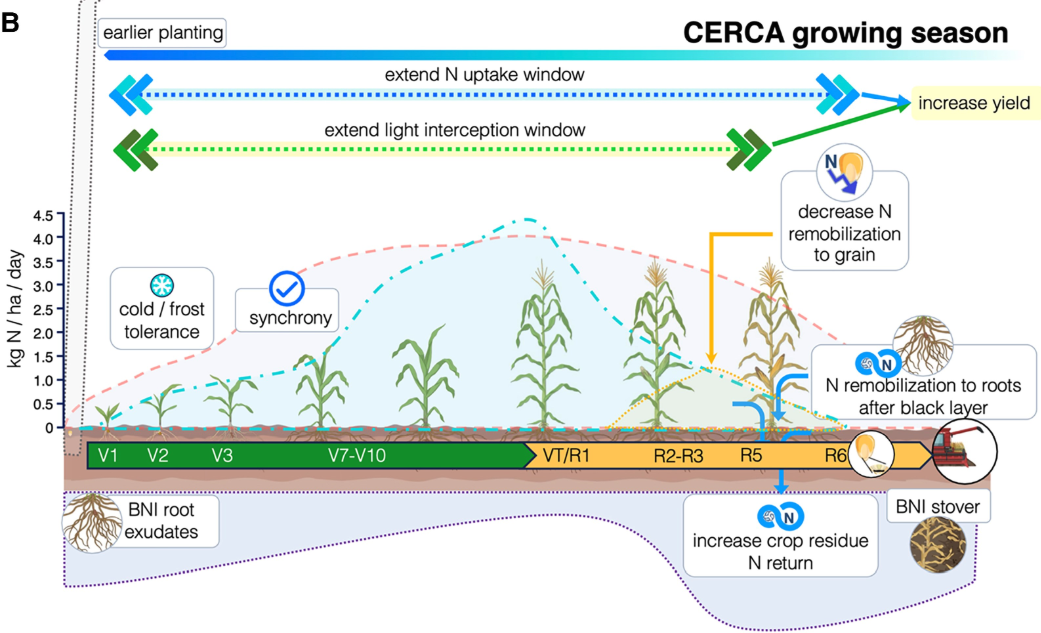Overview
“Designing a nitrogen-efficient cold-tolerant maize for modern agricultural systems” (Ojeda-Rivera et al., 2025) introduces the CERCA ideotype—a conceptual maize blueprint that synchronizes crop growth with natural nitrogen cycling. The paper identifies long-standing bottlenecks in temperate maize production (cold sensitivity and nitrogen wastage) and proposes an integrated suite of genetic, physiological, and agronomic traits to overcome them.
Key Highlights
Seedling Cold Tolerance & Early Planting Targeting germination at 6 °C and leaf growth below 10 °C could shift typical U.S. Corn Belt planting from May to early April, adding >10 % yield potential while curbing spring nitrate losses.
Nitrogen Recycling on the Farm
- Reduce grain protein to ≈ 4 % by down-regulating low-quality zeins, cutting field nitrogen removal ~50 %.
- Alternative late-season sinks—retain N in cobs, stalks, and roots (“stay-alive” roots) for gradual release the following spring.
Biological Nitrification Inhibition (BNI)
Boosting production of benzoxazinoid-derived BNI metabolites (HDMBOA, MBOA, etc.) in roots and residue could stabilize ammonium and slash off-season leaching and N₂O emissions.Multidisciplinary Roadmap Combines comparative genomics (maize, Tripsacum, Miscanthus), machine-learning–guided regulatory discovery, crop-growth modelling (APSIM/DSSAT), and advanced transformation tactics (e.g., Wus2-facilitated editing).
Major Findings
Two Core Anomalies Drive Inefficiency
- Seasonal mismatch: maize’s tropical origins preclude early-spring planting, leaving soil N un-scavenged.
- Excess grain storage protein: 60 % + of applied fertilizer ends up in low-value kernel proteins.
CERCA Trait Bundle Feasibility
- Natural diversity and wild relatives already harbor alleles for frost tolerance, N remobilization, and BNI.
- Stay-green genetics and grain-protein selection experiments show simultaneous yield gain and N reduction is achievable.
System-Level Impact Simulations suggest >20 % fertilizer-N savings, ~10–15 % yield gains, and marked reductions in nitrate runoff and greenhouse-gas emissions.
Impact on Plant Genomics & Breeding
The CERCA framework shifts the breeding target from “per-plant nitrogen use efficiency” to “system-level nutrient circularity.” By integrating cold resilience, metabolic re-allocation, and root-microbe interactions:
- Breeders gain trait modules that can be stacked gradually into elite hybrids.
- Researchers obtain a priority list of candidate genes (e.g., CBF/ICE network, lipid-desaturases, amino-acid permeases, benzoxazinoid biosynthetic enzymes) for CRISPR/Cas editing.
- Policymakers and industry see a viable path to meeting production goals while lowering environmental footprints.
Data & Methods Snapshot
| Component | Details |
|---|---|
| Literature & Meta-analysis | >200 studies synthesized on cold physiology, NUE, BNI, and perennial nutrient cycling. |
| Comparative Genomics | 30 + Andropogoneae genomes, deep-learning motif transfer to pinpoint conserved cold/BNI loci. |
| Crop Modelling | APSIM & DSSAT scenarios: early planting + 50 % N-rate reduction + BNI residues. |
| Proof-of-Concept Experiments | Frost-tolerant Tripsacum × maize F₂s; zein knockdown lines; residue-BNI incubation assays. |
Full Paper
Read the open-access article here → Plant Cell doi:10.1093/plcell/koaf139
